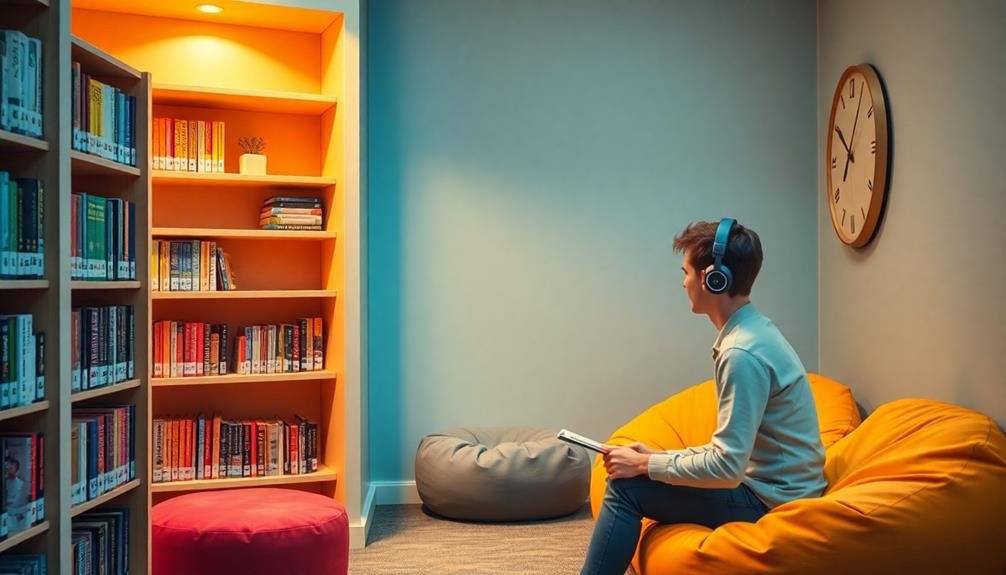Libraries are increasingly offering inclusive programs for readers with anxiety. You'll find quiet zones and sensory-friendly spaces designed to reduce stress. Many libraries now provide low-pressure book clubs, anxiety-reducing book recommendations, and gradual exposure reading programs. Sensory-friendly story times cater to children who may feel overwhelmed. Staff training guarantees librarians can offer supportive, one-on-one assistance. Mindfulness workshops help you develop coping strategies for reading-related stress. Virtual participation options allow you to engage from the comfort of home. With up to 40% of adults experiencing reading anxiety, these initiatives are transforming libraries into welcoming havens for all. Discover how these programs can enhance your reading experience.
Understanding Reader Anxiety

While many people enjoy reading, some individuals experience anxiety when faced with books or reading tasks. This condition, known as reader anxiety, can manifest in various ways. You might feel overwhelmed by large blocks of text, struggle to concentrate, or worry about your reading speed and comprehension.
Reader anxiety often stems from past negative experiences, learning difficulties, or societal pressures. It's not limited to those with diagnosed reading disorders; anyone can experience it. You may find yourself avoiding reading altogether, which can impact your academic, professional, and personal life.
Common symptoms include physical discomfort, such as sweating or increased heart rate, when attempting to read. You might also experience racing thoughts, self-doubt, or a sense of shame about your reading abilities.
It's important to recognize that reader anxiety is a real issue and not a reflection of your intelligence or worth. Understanding reader anxiety is essential for developing effective coping strategies and creating inclusive library environments.
Creating Safe Library Spaces
You can transform your library into a haven for anxious readers by implementing key features.
Start by designating quiet zones where patrons can read or work without disturbance.
Create sensory-friendly environments with adjustable lighting, comfortable seating, and noise-reducing elements.
Don't forget to install clear signage and intuitive wayfinding to help visitors navigate the space confidently.
Quiet Zones
In light of the growing need for inclusive spaces, libraries are increasingly setting up designated quiet zones to accommodate readers with anxiety. These areas provide a calm environment where you can read, study, or simply relax without the distractions of noise or excessive activity.
You'll find that quiet zones are typically located in secluded corners of the library, away from high-traffic areas. They're often furnished with comfortable seating, soft lighting, and sound-absorbing materials to minimize noise. Some libraries even offer noise-canceling headphones for added comfort.
When you're in a quiet zone, you'll notice clear signage indicating noise restrictions. Staff members are trained to gently enforce these rules, ensuring a peaceful atmosphere for all patrons. You're encouraged to use these spaces for silent activities, such as reading, writing, or quiet contemplation.
Many libraries also provide resources specifically for anxiety management within these zones. You might find books on mindfulness, stress reduction techniques, or even fidget toys to help you stay calm and focused.
Sensory-Friendly Environments
Beyond quiet zones, libraries are now embracing sensory-friendly environments to create safe spaces for readers with anxiety and sensory sensitivities.
You'll find these areas designed with muted colors, soft lighting, and comfortable seating to reduce visual and tactile stimuli. Libraries often incorporate noise-canceling headphones, weighted blankets, and fidget toys to help patrons self-regulate.
In these spaces, you'll notice adjustable lighting options, allowing you to control brightness levels. Some libraries offer sensory kits with items like stress balls, textured cushions, and noise-reducing earmuffs.
You might also find calming visual elements such as nature scenes or abstract art.
To further accommodate diverse needs, libraries are installing white noise machines and providing scent-free zones.
You'll see clearly marked exits and quiet corners for those who need a quick retreat. Some libraries even offer timed sensory-friendly hours, during which they adjust lighting and sound levels throughout the entire building.
Clear Signage and Wayfinding
Clear signage and intuitive wayfinding play essential roles in creating safe library spaces for readers with anxiety. When you're designing your library's layout, consider how easily patrons can navigate the space without needing to ask for help. Use large, legible fonts and high-contrast colors for all signs.
Implement a consistent visual system throughout the library, including color-coding for different sections or floors. Create a clear map of the library near the entrance, and provide take-away versions for patrons to carry. Use symbols and pictograms alongside text to assist those with language barriers or reading difficulties.
Install directional signs at key decision points, such as intersections of aisles or stairwells. Make certain that stack end panels clearly display the range of materials in each aisle.
Consider using digital wayfinding tools, such as touchscreen kiosks or mobile apps, to provide interactive maps and search functions. These can help anxious readers locate materials without interacting with staff.
Remember to keep signage up-to-date, replacing worn or outdated signs promptly. By prioritizing clear signage and wayfinding, you'll create a more welcoming and accessible environment for all library users, especially those with anxiety.
Quiet Reading Zones

When designing quiet reading zones for anxious patrons, you'll want to focus on creating designated low-stimulation areas.
These spaces should minimize visual and auditory distractions, offering a calm environment for focused reading.
Consider incorporating sensory-friendly elements like soft lighting, comfortable seating, and noise-cancelling headphones to further enhance the reading experience for those with anxiety.
Designated Low-Stimulation Areas
Tranquility forms the foundation of designated low-stimulation areas in libraries.
These spaces are specifically designed to minimize sensory input, providing a calm environment for readers with anxiety. You'll find these areas strategically located away from high-traffic zones, reducing noise and visual distractions.
In these low-stimulation areas, you'll notice soft, neutral colors on the walls and furniture.
Lighting is often adjustable, allowing you to control the brightness to your comfort level. Sound-absorbing materials, such as carpets and acoustic panels, help maintain a peaceful atmosphere.
You'll have access to comfortable seating options, including bean bags, cushioned chairs, and small cubicles for added privacy.
Some libraries offer noise-canceling headphones or white noise machines to further reduce auditory stimulation.
These areas often feature a limited number of carefully curated books and resources, preventing overwhelming choices.
You might also find fidget toys or stress-relief items available for use.
Sensory-Friendly Reading Spaces
Building on the concept of low-stimulation areas, sensory-friendly reading spaces take the idea of quiet zones a step further. These specialized areas are designed to cater to readers who may have sensory processing issues or anxiety. You'll find these spaces equipped with features that minimize sensory input and create a calming environment.
Consider incorporating the following elements in your library's sensory-friendly reading spaces:
| Lighting | Seating | Acoustics |
|---|---|---|
| Dimmable lights | Comfortable chairs | Sound-absorbing panels |
| Soft, warm tones | Weighted blankets | White noise machines |
| Natural light options | Rocking chairs | Noise-canceling headphones |
By providing these features, you're creating a safe haven for readers who might otherwise struggle in a traditional library setting. Remember to offer a variety of seating options to accommodate different preferences and needs. You can also include sensory tools like fidget toys or stress balls to help readers self-regulate.
When designing these spaces, consult with occupational therapists or sensory experts to guarantee you're meeting the diverse needs of your community. By offering sensory-friendly reading spaces, you're making your library more inclusive and welcoming to all readers.
Low-Pressure Book Club Options
Libraries can create inclusive spaces for readers with anxiety by offering low-pressure book club options. These clubs focus on creating a relaxed atmosphere where participants don't feel obligated to speak or finish the entire book.
You'll find that these groups often have flexible attendance policies, allowing you to join when you feel comfortable. Some low-pressure options include silent book clubs, where members read together in a shared space without discussion.
There are also online book clubs that let you participate from home, reducing social anxiety. You might encounter clubs that focus on shorter works like short stories or poetry, making the reading commitment less intimidating.
Many libraries offer "no-prep" book clubs, where you can discuss the book without having finished it. Some organize themed book chats, allowing you to talk about any book within a specific genre or topic.
You'll also find clubs that incorporate relaxation techniques or mindfulness exercises before discussions. These low-pressure options guarantee that readers with anxiety can enjoy the social aspects of book clubs without feeling overwhelmed or judged.
Sensory-Friendly Story Times

You'll find sensory-friendly story times to be a welcoming experience for readers with anxiety.
These sessions offer a quiet, calming environment with visual schedule aids to help participants anticipate what's coming next.
You'll also have access to fidget tools, allowing you to manage your anxiety while enjoying the story.
Quiet, Calming Environment
Tranquility reigns supreme in sensory-friendly story times designed for readers with anxiety.
You'll find a carefully curated environment that prioritizes calm and comfort. The library space is transformed into a soothing oasis, with soft lighting, comfortable seating, and minimal distractions.
To create this quiet, calming atmosphere, you'll notice:
- Noise-canceling headphones available for those sensitive to sound
- Soft, plush cushions and bean bags for cozy seating options
- Nature-inspired decor, like potted plants or wall murals, to promote relaxation
The room's temperature is carefully regulated to guarantee everyone's comfort.
You'll also find designated quiet zones where participants can retreat if they need a moment to themselves.
The librarian's voice remains gentle and steady throughout the session, avoiding sudden volume changes that might startle anxious readers.
Visual Schedule Aids
Visual aids play an essential role in sensory-friendly story times, helping readers with anxiety navigate the program's structure. You'll find that incorporating visual schedule aids can greatly reduce stress and uncertainty for participants. These aids provide a clear, step-by-step outline of the story time activities, allowing readers to anticipate what's coming next.
When creating your visual schedule, use simple, recognizable images paired with short text descriptions. You can display these on a large board or provide individual handouts. Here's an example of a visual schedule for a sensory-friendly story time:
| Time | Activity | Image |
|---|---|---|
| 10:00 | Arrival | �♀️ |
| 10:05 | Welcome Song | � |
| 10:10 | First Story | � |
| 10:20 | Movement Break | �♂️ |
| 10:25 | Second Story | � |
Fidget Tools Available
Fidget tools are invaluable resources for creating a sensory-friendly story time environment. They provide a discreet way for participants to manage anxiety and improve focus during library programs. You'll want to offer a variety of options to accommodate different preferences and needs.
Consider including these fidget tools in your sensory-friendly story times:
- Stress balls or squeezy toys
- Textured fidget cubes
- Silent fidget spinners
When you introduce fidget tools, explain their purpose and demonstrate proper use. Encourage participants to choose a tool that works best for them.
You'll find that many readers appreciate having something to occupy their hands, helping them stay engaged with the story.
Remember to keep the fidget tools clean and sanitized between uses. You might also consider allowing participants to bring their own fidget items from home if they prefer.
Virtual Participation Opportunities
Remote access has become a cornerstone of inclusive library programming, especially for readers with anxiety. You'll find that many libraries now offer virtual book clubs, author talks, and reading groups that you can join from the comfort of your home.
These online options allow you to participate without the stress of in-person interactions. You can access live-streamed events or watch recordings at your convenience. Many libraries use platforms like Zoom or Google Meet, which let you control your level of engagement.
You can choose to turn off your camera or use the chat function if you're not comfortable speaking. Some libraries have created virtual reading rooms where you can join others in quiet, distraction-free digital spaces.
You'll also find online reading challenges and book recommendation services tailored to your preferences. Don't hesitate to reach out to your local library about their virtual offerings.
They may have e-book clubs, digital storytimes, or online workshops that you can join. These virtual opportunities guarantee that you can stay connected to your reading community while managing your anxiety levels.
One-on-One Librarian Support

Libraries' commitment to inclusivity extends to personalized support for readers with anxiety. You'll find that many libraries offer one-on-one librarian assistance tailored to your specific needs. These sessions can help you navigate the library's resources, find books that match your interests, and develop strategies to manage anxiety while reading or visiting the library.
When you request one-on-one support, you can expect:
- A private, judgment-free space to discuss your reading goals and concerns
- Personalized book recommendations based on your preferences and comfort level
- Guidance on using library services and technology with minimal stress
Librarians are trained to provide sensitive, confidential assistance. They'll work with you to create a comfortable environment, whether that means finding quiet spaces in the library or suggesting low-pressure ways to engage with reading materials.
You can also ask for help in developing coping techniques for anxiety-inducing situations, such as crowded events or unfamiliar technology.
Don't hesitate to reach out to your local library about one-on-one support options. Many libraries offer flexible scheduling, including virtual meetings, to accommodate your needs and guarantee you can access the resources and support you deserve.
Anxiety-Reducing Book Recommendations
Beyond personalized support, many libraries curate special collections of anxiety-reducing books. These collections often include titles that focus on mindfulness, meditation, and stress management techniques.
You'll find self-help books written by mental health professionals, as well as fiction that features characters dealing with anxiety in relatable ways.
Look for books that offer practical coping strategies, such as "The Anxiety and Phobia Workbook" by Edmund Bourne or "Dare: The New Way to End Anxiety and Stop Panic Attacks" by Barry McDonagh.
For a lighter approach, consider graphic novels like "Hyperbole and a Half" by Allie Brosh or "Marbles: Mania, Depression, Michelangelo, and Me" by Ellen Forney.
Don't overlook children's and young adult literature, which often address anxiety in accessible ways. "Ruby Finds a Worry" by Tom Percival and "Hey Warrior" by Karen Young are excellent choices for younger readers.
For teens, "Turtles All the Way Down" by John Green offers an authentic portrayal of anxiety.
Gradual Exposure Reading Programs

As libraries expand their inclusive offerings, gradual exposure reading programs are gaining popularity. These programs are designed to help readers with anxiety slowly build their confidence and comfort with reading in various settings.
You'll find that these programs typically start with low-pressure activities and gradually increase in intensity over time.
When participating in a gradual exposure reading program, you might experience:
- One-on-one reading sessions with a librarian or volunteer
- Small group reading circles with other anxious readers
- Larger book club discussions with supportive members
You'll notice that each step is carefully planned to help you feel more at ease. The program may begin with short, simple texts and progress to longer, more complex works.
You're encouraged to set your own pace and communicate your comfort level throughout the process.
Libraries often pair these programs with anxiety-reducing techniques, such as deep breathing exercises or mindfulness practices.
By combining gradual exposure with coping strategies, you're more likely to develop lasting skills for managing reading anxiety.
Mindfulness and Reading Workshops
Mindfulness and reading workshops offer another powerful tool for readers struggling with anxiety. These sessions combine relaxation techniques with reading activities to create a calm, supportive environment. You'll learn to focus on the present moment, reducing worry about past or future events that often fuel anxiety.
In these workshops, you'll practice deep breathing exercises and gentle stretches before beginning to read. You'll be guided through short meditation sessions to clear your mind and increase concentration.
As you read, you'll be encouraged to notice physical sensations, thoughts, and emotions without judgment. The workshops also teach you to approach challenging texts with curiosity rather than fear.
You'll learn to recognize anxiety triggers in your reading and develop coping strategies. Group discussions allow you to share experiences and learn from others facing similar challenges.
Inclusive Library Staff Training

Inclusive library staff training lies at the heart of creating a welcoming environment for readers with anxiety. You'll want to guarantee your team understands the unique challenges these patrons face and how to best support them.
Start by educating staff on various anxiety disorders and their impact on library use. This knowledge will help them empathize and respond appropriately to anxious readers' needs.
Next, focus on practical skills. Teach your staff:
- Non-verbal communication techniques
- De-escalation strategies for panic attacks
- How to offer assistance without overwhelming patrons
Role-playing exercises can be particularly effective in helping staff practice these skills.
You'll also want to cover library policies and procedures that support anxious readers, such as quiet zones or extended borrowing periods.
Don't forget to address staff's own mental health. Provide resources and support for those who may experience secondary stress from helping anxious patrons.
Regular check-ins and team debriefs can help maintain a supportive work environment.
Frequently Asked Questions
How Can Libraries Collaborate With Mental Health Professionals for These Programs?
You can partner with local therapists or counselors to develop and lead workshops. Invite them to give talks on anxiety management. Collaborate on creating resource lists and reading recommendations. Consider offering joint consultations or referral services for patrons.
Are There Any Specific Accessibility Considerations for Anxious Readers With Disabilities?
You'll need to contemplate physical accessibility, sensory-friendly spaces, and assistive technologies. Offer large print books, audiobooks, and e-readers. Provide quiet zones, fidget tools, and adjustable lighting. Don't forget to train staff on disability awareness and communication techniques.
What Age Groups Benefit Most From Inclusive Library Programs for Anxiety?
You'll find inclusive anxiety programs benefit all ages, from children to seniors. They're especially impactful for teens and young adults managing social pressures. However, don't overlook the needs of middle-aged adults dealing with work-related stress.
How Can Libraries Measure the Success of Anxiety-Focused Reading Initiatives?
You can measure success through participant surveys, attendance rates, and feedback forms. Track engagement levels, repeat visits, and circulation statistics. Observe behavioral changes and collect testimonials. Monitor social media mentions and community partnerships related to your anxiety-focused reading initiatives.
Are There Grant Opportunities Available for Implementing Anxiety-Friendly Library Programs?
You'll find numerous grant opportunities for anxiety-friendly library programs. Check with organizations like ALA, IMLS, and state library associations. Don't forget local foundations and community groups. They're often enthusiastic to support innovative, inclusive library initiatives.
In Summary
You've taken important steps to make your library more welcoming for readers with anxiety. By creating safe spaces, offering low-pressure programs, and training staff, you're breaking down barriers to reading enjoyment. Remember, every small change can make a big difference. Keep listening to your patrons' needs and adapting your services accordingly. With your continued efforts, you'll foster a truly inclusive environment where all readers can thrive, regardless of their anxiety levels.





Leave a Reply